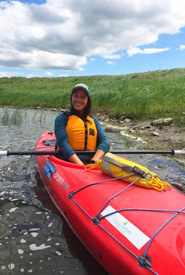Step into the wilderness with just a 15-minute paddle from the city
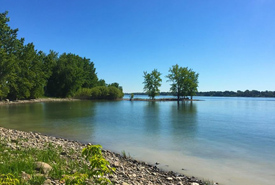
A beach in the Hochelaga Archipelago (Photo by NCC)
I like to imagine the St. Lawrence islands like treasures situated in the middle of the river; little parcels of paradise that were accidentally dropped into our province, just two steps from Montreal. Stéphanie Drouin-L’Hérault and I are two biology students who pursued an internship this past summer with the Nature Conservancy of Canada (NCC).
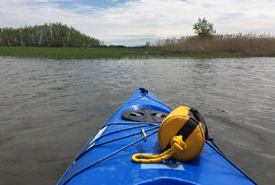
My trusty kayak (Photo by NCC)
Each work day, accompanied by my colleague, I step into my kayak (while making sure not to fall into the water!), with a water bottle, sunscreen and a paddle, ready to discover what the islands have to offer. I glide on the water, slowly but surely. I keep my senses peeled on the wind, the waves and the sky to make sure I get to my destination safe and sound.
I paddle to the first island, the one that I can see as soon as I leave the shores of Park Saint-Laurent, in Repentigny. Yep, I’m talking about l’île aux Cerfeuils.
I paddle closer…I get ready to disembark…
“Wow! Did you see that, Steph? Right there in the water...the fish that jumped! It was huge!” I pull up on the bank, my eyes fixed on the sea grass meadows that surround me, in the hopes that I might get a glimpse of the infamous copper redhorse.
“You know, Steph, this species is only found here!”
Lifting myself out of the kayak (once again being careful not to fall in the water!), I step one foot and then the other onto the shore. I remove my lifejacket and leave it here while I explore the island.
“I love what they’ve done here, Steph. The bridged trail that leads to the observation platform is a great idea.” Walking along the trail, with Stéphanie to my right, I spot a gartersnake to my left.
“A gartersnake! Wow! I’ve never seen one before today.”
I walk determinedly ahead, because I see the platform in the distance and I can’t wait to see the view from up high. I climb the steps, and finally I can see a pond full of flowering waterlilies, Canada goose and their young.
“They’re so beautiful, Steph. They almost look like adolescents, because their heads are almost black.”
I would stay here for hours, but I must also go explore trails on another island.
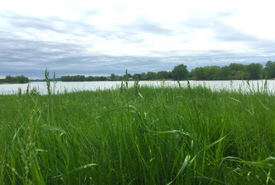
Eagle Island (Photo by NCC)
L’île à l’Aigle is so big that NCC has built two platforms and three docks to ensure that many people can enjoy the site.
“Did you see, Steph? L’île à l’Aigle is actually shaped like a bird’s head. I wonder if they knew that when they named the island?”
Getting back into my kayak, I don my life jacket once again and head to L’île à l’Aigle. The journey there lasts no longer than five minutes. Getting out one more time, I walk briskly on the trail, which is a little different from that on the l’île aux Cerfeuils, because here the grass has only been mowed.
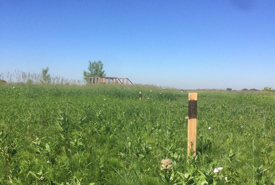
One of the two platforms NCC built for people to enjoy the site (Photo by NCC)
I head toward the second platform of the day. Climbing the stairs, I look up at the sky and see a small bird flying so fast that I can’t identify it.
“Do you think it’s a bank swallow? It looks like they were able to build their nest in the soft material of the eroded banks.”
I try to look more closely, because I’ve heard that others have spotted a barred owl here.
“Steph, did you know that it’s Quebec’s only diurnal owl?”
I could spend all day here observing my surroundings, but I must get back. I turn around, head back to my kayak, and quietly glide back to the shores of Repentigny, looking forward to what l’île Bonfoin and l’île Beauregard have in store for me.
The Conservation Internship Program is funded in part by the Government of Canada’s Summer Work Experience program.

